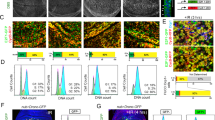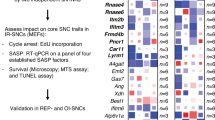Abstract
p8 is a stress-induced DNA-binding protein, biochemically related to the architectural chromatin binding HMG protein family and whose function is presently unknown. We obtained fibroblast from mice lacking p8 and found that p8 is involved in cell growth regulation and in apoptosis. p8−/− mouse embryonic fibroblasts (MEFs) grow more rapidly than p8+/+ MEFs. This might be explained by the higher intracellular level and activity of the Cdk2 and Cdk4 observed in p8−/− MEFs, which in turn may result, at least in part, from the concomitant decrease observed in the amount of cyclin-dependent kinase inhibitor p27. We also report that p8 mRNA expression is strongly activated in fibroblasts after cell growth arrest induced by serum deprivation or confluence. As expected, MEFs expressing p8 arrest their growth more rapidly after serum deprivation than MEFs lacking p8, which strongly suggests that p8 over-expression is implicated in cell growth arrest. On the other hand, p8+/+ MEFs are more sensitive than p8−/− MEFs to the apoptosis induced by adriamycin treatment. p53 might be involved, as p8 expression increases its intracellular amount and trans-activation capacity. Finally, demonstration that p53 is a negative trans-activator of p8 suggests the presence of a complex autoregulatory loop. In conclusion, p8 is a cell growth inhibitor that facilitates apoptosis induced in fibroblasts by DNA damage.
This is a preview of subscription content, access via your institution
Access options
Subscribe to this journal
Receive 50 print issues and online access
$259.00 per year
only $5.18 per issue
Buy this article
- Purchase on Springer Link
- Instant access to full article PDF
Prices may be subject to local taxes which are calculated during checkout






Similar content being viewed by others
References
Allen RG, Tresini M . 2000 Free Radic. Biol. Med. 28: 463–499
Amundson SA, Myers TG, Fornace AJ . 1998 Oncogene 17: 3287–3299
Bratland K, Risberg K, Maelandsmo GM, Gutzkow KB, Olsen OE, Moghaddam A, Wang MY, Hansen CM, Blomhoff HK, Berg JP, Fodstad O, Ree AH . 2000 Cancer Res. 60: 5578–5583
Buckbinder L, Talbott R, Velasco-Miguel S, Takenaka I, Faha B, Seizinger BR, Kley N . 1995 Nature 377: 646–649
Colman MS, Afshari CA, Barrett JC . 2000 Mutat. Res. 462: 179–188
Dameron KM, Volpert OV, Tainsky MA, Bouck N . 1994 Science 265: 1582–154
Donehower LA, Harvey M, Slagle BL, McArthur MJ, Montgomery CA, Butel JS, Bradley A . 1992 Nature 356: 215–321
Encinar JA, Mallo GV, Mizyrycki C, Giono L, Gonzalez-Ros JM, Rico M, Canepa E, Moreno S, Neira JL, Iovanna JL . 2001 J. Biol. Chem. 276: 2701–2707
Farmer G, Colgan J, Nakatani Y, Manley JL, Prives C . 1996 Mol. Cell. Biol. 16: 4295–4304
Garrington TP, Johnson GL . 1999 Curr. Opin. Cell. Biol. 11: 211–218
Goldschmidt-Clermont PJ, Moldovan L . 1999 Gene Expr. 7: 255–260
Hartwell LH, Kastan MB . 1994 Science 266: 1821–1828
Harvey DM, Levine AJ . 1991 Genes Dev. 5: 2375–2385
Harvey M, Sands AT, Weiss RS, Hegi ME, Wiseman RW, Pantazis P, Giovanella BC, Tainsky MA, Bradley A, Donehower LA . 1993 Oncogene 8: 2457–2467
Hollstein M, Sidransky D, Vogelstein B, Harris CC . 1991 Science 253: 49–53
Ichijo H . 1999 Oncogene 18: 6087–6093
Jiang YF, Vaccaro MI, Fiedler F, Calvo EL, Iovanna JL . 1999 Biochem. Biophys. Res. Commun. 260: 686–690
Kaufman RJ . 1999 Genes Dev. 13: 1211–1233
Ko LJ, Prives C . 1996 Genes Dev. 10: 1054–1072
Kuhbandner S, Brummer S, Metzger D, Chambon P, Hofmann F, Feil R . 2000 Genesis. 28: 15–22
Mallo GV, Fiedler F, Calvo EL, Ortiz EM, Vasseur S, Keim V, Morisset J, Iovanna JL . 1997 J. Biol. Chem. 272: 32360–32369
Martin DW, Munoz RM, Subler MA, Deb S . 1993 J. Biol. Chem. 268: 13062–13067
Michalovitz D, Halevy O, Oren M . 1990 Cell 62: 671–680
Pesch J, Brehm U, Staib C, Grummt F . 1996 J. Interferon Cytokine Res. 16: 595–600
Polyak K, Waldman T, He TC, Kinzler KW, Vogelstein B . 1996 Genes Dev. 10: 1945–1952
Ragimov N, Krauskopf A, Navot N, Rotter V, Oren M, Aloni Y . 1993 Oncogene 8: 1183–1193
Ree AH, Tvermyr M, Engebraaten O, Rooman M, Rosok O, Hovig E, Meza-Zepeda LA, Bruland OS, Fodstad O . 1999 Cancer Res. 59: 4675–4680
Sambrook J, Fritsch EF, Maniatis T . 1989 Molecular Cloning: A Laboratory Manual. 2nd edn Plainview, NY: Cold Spring Harbor Lab. Press
Schulze-Osthoff K, Ferrari D, Los M, Wesselborg S, Peter ME . 1998 Eur. J. Biochem. 254: 439–459
Seed B, Sheen JY . 1988 Gene 67: 271–277
Seto E, Usheva A, Zambetti GP, Momand J, Horikoshi N, Weinmann R, Levine AJ, Shenk T . 1992 Proc. Natl. Acad. Sci. USA. 89: 12028–12032
Shackelford RE, Kaufmann WK, Paules RS . 1999 Environ Health Perspect. 107: 5–24
Stronach BE, Perrimon N . 1999 Oncogene 18: 6172–6182
Su SB, Motoo Y, Iovanna JL, Xie MJ, Mouri H, Ohtsubo K, Yamaguchi Y, Watanabe H, Okai T, Matsubara F, Sawabu N . 2001 Clin. Cancer Res. 7: 309–313
Subbaramaiah K, Altorki N, Chung WJ, Mestre JR, Sampat A, Dannenberg AJ . 1999 J. Biol. Chem. 274: 10911–10915
Utz PJ, Anderson P . 2000 Cell Death Differ. 7: 589–602
Vasseur S, Mallo GV, Fiedler F, Bodeker H, Canepa E, Moreno S, Iovanna JL . 1999a Eur. J. Biochem. 259: 670–675
Vasseur S, Mallo GV, Garcia Montero A, Ortiz E, Fiedler F, Canepa E, Moreno S, Iovanna JL . 1999b Biochem. J. 343: 377–383
Wang E, Marcotte R, Petroulakis E . 1999 J. Cell. Biochem. 32–33: 95–102
Zhai W, Comai L . 2000 Mol. Cell. Biol. 20: 5930–5938
Zhang L, Yu D, Hu M, Xiong S, Lang A, Ellis LM, Pollock RE . 2000 Cancer Res. 60: 3655–3661
Acknowledgements
We thank Drs H Cremer, S Garcia, M Monte and N Dusetti for insightful discussions and critical evaluation of the manuscript and to Dr A Levine for provide us the 10.1 and Val5 cells. Supported by grants from Société de Secours des Amis des Sciences and EMBO short fellowship (S Vasseur), Fondation pour la Recherche Médicale (A Hoffmeister), poste orange INSERM (A Garcia-Montero), and the Humboldt Foundation (GV Mallo). This work was supported by a grant from the Ligue de Lutte Contre le Cancer.
Author information
Authors and Affiliations
Corresponding author
Rights and permissions
About this article
Cite this article
Vasseur, S., Hoffmeister, A., Garcia-Montero, A. et al. p8-deficient fibroblasts grow more rapidly and are more resistant to adriamycin-induced apoptosis. Oncogene 21, 1685–1694 (2002). https://doi.org/10.1038/sj.onc.1205222
Received:
Revised:
Accepted:
Published:
Issue Date:
DOI: https://doi.org/10.1038/sj.onc.1205222
Keywords
This article is cited by
-
Prothioconazole induces cell cycle arrest by up-regulation of EIF4EBP1 in extravillous trophoblast cells
Archives of Toxicology (2022)
-
Inactivation of NUPR1 promotes cell death by coupling ER-stress responses with necrosis
Scientific Reports (2018)
-
Nidogen 1 and Nuclear Protein 1: novel targets of ETV5 transcription factor involved in endometrial cancer invasion
Clinical & Experimental Metastasis (2015)
-
Cytokine systems approach demonstrates differences in innate and pro-inflammatory host responses between genetically distinct MERS-CoV isolates
BMC Genomics (2014)
-
Nupr1 deletion protects against glucose intolerance by increasing beta cell mass
Diabetologia (2013)



